The evaporative function of cockroach hygroreceptors
- PMID:23342058
- PMCID: PMC3546976
- DOI: 10.1371/journal.pone.0053998
The evaporative function of cockroach hygroreceptors
Abstract
Insect hygroreceptors associate as antagonistic pairs of a moist cell and a dry cell together with a cold cell in small cuticular sensilla on the antennae. The mechanisms by which the atmospheric humidity stimulates the hygroreceptive cells remain elusive. Three models for humidity transduction have been proposed in which hygroreceptors operate either as mechanical hygrometers, evaporation detectors or psychrometers. Mechanical hygrometers are assumed to respond to the relative humidity, evaporation detectors to the saturation deficit and psychrometers to the temperature depression (the difference between wet-bulb and dry-bulb temperatures). The models refer to different ways of expressing humidity. This also means, however, that at different temperatures these different types of hygroreceptors indicate very different humidity conditions. The present study tested the adequacy of the three models on the cockroach's moist and dry cells by determining whether the specific predictions about the temperature-dependence of the humidity responses are indeed observed. While in previous studies stimulation consisted of rapid step-like humidity changes, here we changed humidity slowly and continuously up and down in a sinusoidal fashion. The low rates of change made it possible to measure instantaneous humidity values based on UV-absorption and to assign these values to the hygroreceptive sensillum. The moist cell fitted neither the mechanical hygrometer nor the evaporation detector model: the temperature dependence of its humidity responses could not be attributed to relative humidity or to saturation deficit, respectively. The psychrometer model, however, was verified by the close relationships of the moist cell's response with the wet-bulb temperature and the dry cell's response with the dry-bulb temperature. Thus, the hygroreceptors respond to evaporation and the resulting cooling due to the wetness or dryness of the air. The drier the ambient air (absolutely) and the higher the temperature, the greater the evaporative temperature depression and the power to desiccate.
Conflict of interest statement
Figures
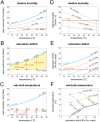
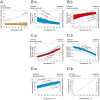
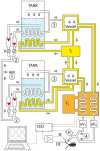



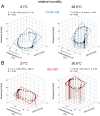

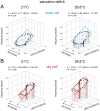




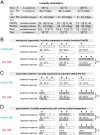
Similar articles
- Revisiting Theories of Humidity Transduction: A Focus on Electrophysiological Data.Tichy H, Hellwig M, Kallina W.Tichy H, et al.Front Physiol. 2017 Sep 5;8:650. doi: 10.3389/fphys.2017.00650. eCollection 2017.Front Physiol. 2017.PMID:28928673Free PMC article.
- Insect hygroreceptor responses to continuous changes in humidity and air pressure.Tichy H, Kallina W.Tichy H, et al.J Neurophysiol. 2010 Jun;103(6):3274-86. doi: 10.1152/jn.01043.2009. Epub 2010 Apr 7.J Neurophysiol. 2010.PMID:20375249Free PMC article.
- Antennal hygroreceptors of the honey bee, Apis mellifera L.Yokohari F, Tominaga Y, Tateda H.Yokohari F, et al.Cell Tissue Res. 1982;226(1):63-73. doi: 10.1007/BF00217082.Cell Tissue Res. 1982.PMID:7127426
- The evolution of wetness perception: A comparison of arachnid, insect and human models.Merrick C, Filingeri D.Merrick C, et al.J Therm Biol. 2019 Oct;85:102412. doi: 10.1016/j.jtherbio.2019.102412. Epub 2019 Sep 10.J Therm Biol. 2019.PMID:31657753Review.
- Human skin wetness perception: psychophysical and neurophysiological bases.Filingeri D, Havenith G.Filingeri D, et al.Temperature (Austin). 2015 Feb 3;2(1):86-104. doi: 10.1080/23328940.2015.1008878. eCollection 2015 Jan-Mar.Temperature (Austin). 2015.PMID:27227008Free PMC article.Review.
Cited by
- The antennal scape organ of Scutigera coleoptrata (Myriapoda) and a new type of arthropod tip-pore sensilla integrating scolopidial components.Sombke A, Rosenberg J, Hilken G, Müller CHG.Sombke A, et al.Front Zool. 2021 Nov 4;18(1):57. doi: 10.1186/s12983-021-00442-9.Front Zool. 2021.PMID:34736489Free PMC article.
- Neural Code for Ambient Heat Detection in Elaterid Beetles.Merivee E, Must A, Nurme K, Di Giulio A, Muzzi M, Williams I, Mänd M.Merivee E, et al.Front Behav Neurosci. 2020 Feb 6;14:1. doi: 10.3389/fnbeh.2020.00001. eCollection 2020.Front Behav Neurosci. 2020.PMID:32116586Free PMC article.
- Independent processing of increments and decrements in odorant concentration by ON and OFF olfactory receptor neurons.Tichy H, Hellwig M.Tichy H, et al.J Comp Physiol A Neuroethol Sens Neural Behav Physiol. 2018 Nov;204(11):873-891. doi: 10.1007/s00359-018-1289-6. Epub 2018 Sep 24.J Comp Physiol A Neuroethol Sens Neural Behav Physiol. 2018.PMID:30251036Free PMC article.Review.
- Revisiting Theories of Humidity Transduction: A Focus on Electrophysiological Data.Tichy H, Hellwig M, Kallina W.Tichy H, et al.Front Physiol. 2017 Sep 5;8:650. doi: 10.3389/fphys.2017.00650. eCollection 2017.Front Physiol. 2017.PMID:28928673Free PMC article.
- Abiotic and Biotic Factors Regulating Inter-Kingdom Engagement between Insects and Microbe Activity on Vertebrate Remains.Jordan HR, Tomberlin JK.Jordan HR, et al.Insects. 2017 May 24;8(2):54. doi: 10.3390/insects8020054.Insects. 2017.PMID:28538664Free PMC article.Review.
References
- Altner H, Schaller-Selzer L, Stetter H, Wohlrab I (1983) Poreless sensilla with inflexible socket. Cell Tissue Res 234: 279–307. - PubMed
- Altner H, Loftus R (1985) Ultrastructure and function of insect thermo- and hygroreceptors. Annu Rev Entomol 30: 273–295.
- Steinbrecht RA (1999) Bimodal thermo- and hygrosensitive sensilla. In: Harrison FW, Locke M, editors. Microscopic Anatomy of Invertebrates, Wiley-Liss, New York: 405–422.
- Tichy H, Loftus R (1996) Hygroreceptors in insects and a spider: humidity transduction models. Naturwissenschaften 83: 255–263.
- Yokohari F (1999) Hygro- and thermoreceptors. In: Eguchi E, Tominaga Y, editors. Atlas of Arthropod Sensory Receptors. Springer, Berlin Heidelberg New York, 191–210.
Publication types
MeSH terms
Grants and funding
LinkOut - more resources
Full Text Sources
Other Literature Sources
